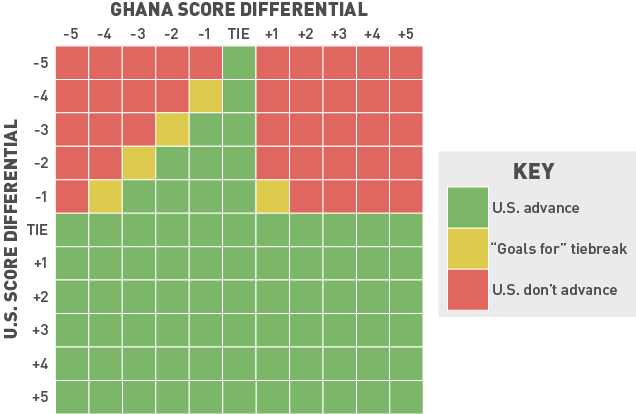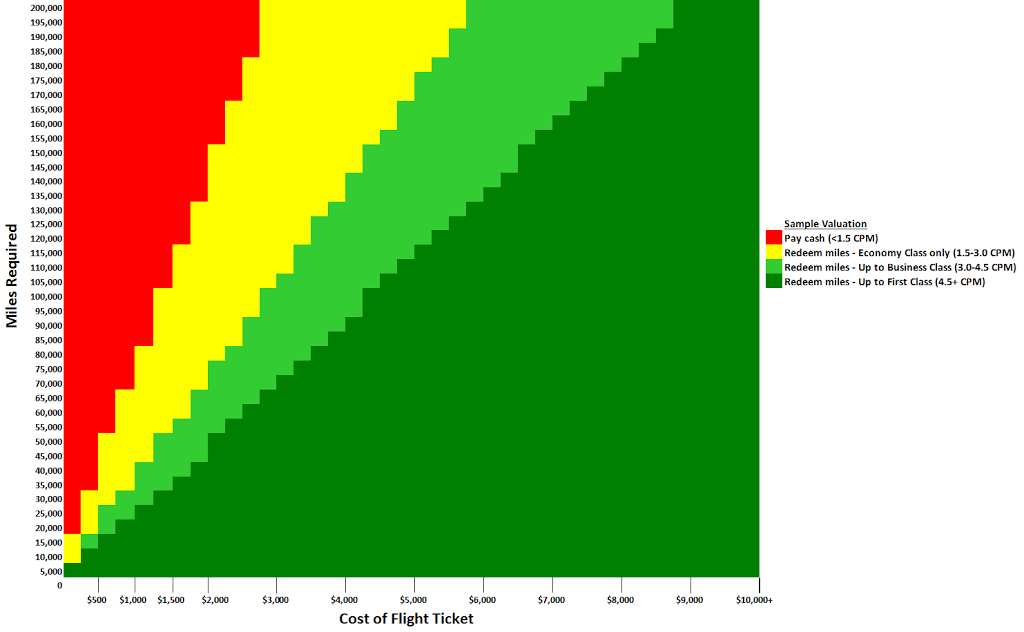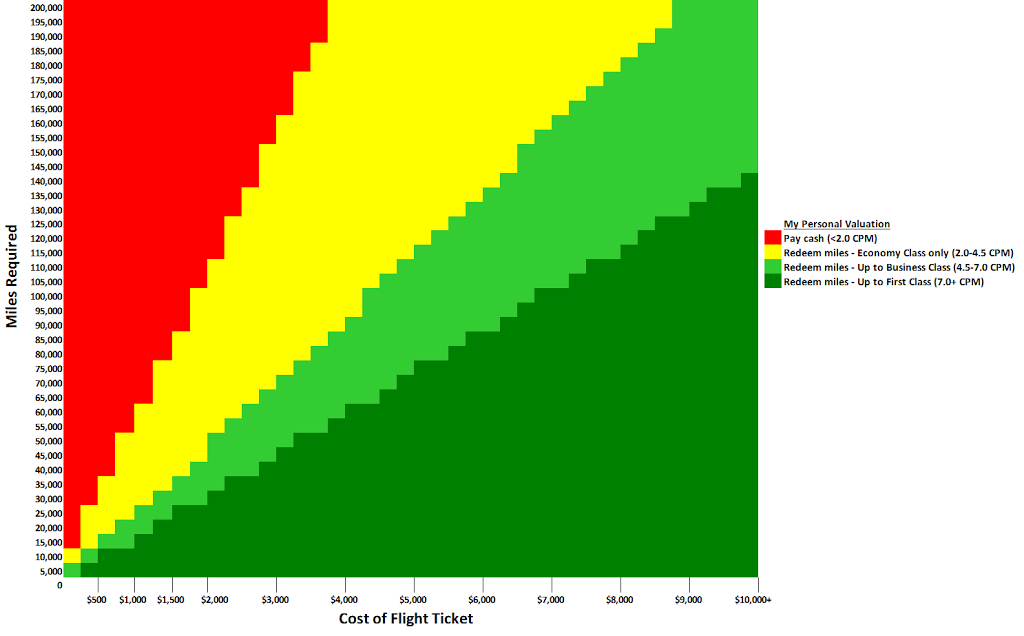When To Use Airline Miles For Flights And Which Class To Book: A Visual Cheat Sheet

It’s been well documented and discussed by many (Lucky does a great job in a series of posts on this topic, the most recent of which is here) about the value of airline miles. In extreme cases, First Class airfare tickets can sell for as much as $20,000, and if that same seat is bookable using 160,000 miles, that puts the value of those miles at 12.5 cents-per-miles (CPM). But while I was willing to pay the sticker price for the sandwich and car in my previous example, would I really be willing to pay $20,000 for that First Class seat? Heck no. In fact, my personal valuation of First Class tickets is closer to 3X the cost of an Economy ticket on that same flight. That would bring the value of the First Class ticket in that example down to something like $5,000, and the CPM of that particular redemption down to 3.1 CPM.
I was inspired by a post I read over at Deadspin during the World Cup where they outlined how all of the potential scenarios of the US vs. Portugal and Germany vs. Ghana games would impact the US’s advancement into the next round of the tournament. I really liked the way the chart was presented, which grouped each of the 121 discrete outcomes into just three color-coded scenarios.
For some reason, that chart popped into my head when I was recently searching for award availability, and mulling over the value I would be getting on each possible redemption. Similar to the chart above, my thought-process was a series of decisions based on discrete scenarios, but instead of looking at goal differential I was comparing CPM of various Economy, Business, and First Class redemptions relative to my desired or target thresholds.
I imagine that’s a similar question many of you ask yourselves each time you want to use airline miles – “Is the CPM for this particular booking a good use of my miles?” The key here is that we can all agree that “good” is subjective, with some people valuing tickets using the actual sticker price, and others like myself, using something much lower.
Based on an illustrative person’s valuation of miles, the chart below shows a sample cheat sheet of when that person should use miles vs. cash for flights. It also shows the situations when using miles, when that person should book Economy, Business, or First Class tickets. Each cell in the chart represents a discrete situation based on number of miles required for a flight (Y-axis) and the cost of the flight ticket (X-axis). Baked into the CPM thresholds outlined in the key on the right, is the value that this person has placed on their miles at each booking class, which again will differ from person-to-person, and even by airline program.
For example let’s say that this person is presented with the opportunity to redeem 140,000 miles on a flight redemption. At what point should they use miles, and if using miles, which class of ticket should they book? Based on this person’s CPM targets, they would pay cash (shown in red) for any ticket up to a value of 1.5 CPM (~$2,100). Anything above that, then they would be willing to use miles. A similar decision-making process when choosing the class of booking. Based on this person’s valuation of Business and First Class tickets relative to Economy class, they would be willing to book Business Class (in light green) within a range of 3.0-4.5 CPM in value ($4,200-$6,300), and First Class at a CPM greater value than 4.5 CPM ($6,300+).
It’s important to note that the chart isn’t saying anything about the typical number of miles needed to make a booking at each class (I know that it would be rare to need 140,000 miles to book an Economy ticket). Instead, it’s simply showing the break-points at which this person would find enough CPM value to make a particular booking. For example, if someone was offered Business Class tickets for 140,000 miles and valued at $4,000, they they would happily make that booking since the value exceeds their target thresholds. However, the value would be too low to be considered an acceptable First Class booking.
As I mentioned, the key assumption here is baked into the CPM thresholds, which is each individual’s valuation of their miles. Personally, I value Business Class tickets at only 2X the value of Economy tickets, even though they can easily cost 3-4x as much. Similarly, I value First Class tickets around 3X the cost of Economy, while actual costs can easily be 6-10X as much. Therefore, I have a lower value on premium cabin tickets than the sample person above, and therefore would require higher CPM redemption values before willing to make the same booking, as illustrated in the chart below:
As you can see here, while the sample person would be willing to book First Class tickets for 140,000 valued at $6,300, I wouldn’t be willing to make that booking unless the flight ticket cost exceeded $9,800.
A couple of notes on methodology – I chunked the mileage redemptions into 5,000 mile increments, and the cost of flight tickets into $250 increments. While there is a clear line drawn between the colors, in reality there is a grey area between neighboring cells that cross into different colors. This would be especially prevalent in low mileage / low cost redemptions that you would find with domestic tickets.
So did I solve the million-dollar question “what is the value of airline miles?” Nope. But the value of this exercise for me was to, through some trial and error, determine what my “acceptable” thresholds really are that I am looking to get out each type of booking. Until now, it’s a calculation that I had been doing anyways each time I looked at a potential redemption, but this was a good way to visualize the entire spectrum and to really see where those break points are.
I’m curious, what is your process for determining when an airline mileage redemption is a “good” value?


As a newly addicted points/miles guy, I now compare every semi-big purchase I make to see if its worth more to pay cash/redeem with points. Yet the variation of some of the value for airlines/hotels is frustrating.
I’d use nerdwallet’s $/1k points or miles to determine cpm or cpp, and use that to compare with the actual cost of the thing. Personally, considering opportunity costs (i.e. to earn extra points/miles through spending), it should be at least 50% more than the cash amount to redeem.
There are so many other variation in play here. For example, I recently redeemed a UA RT flight from IND-SEA for 25k miles. It normally cost somewhere around $300~400, or upwards of $500~$600 depending on the season. But having generated around 20k miles through a recent flight, I was able to use that towards a Saver’s award of (which comes to about $375 on a 1.5 cpm valuation, or more if higher). In the end, it was worth it, because the points was generated through another planned travel, so it seems like the cpm would be even lower (higher?).
I hope I made sense. 🙂 If not, I want to just say… great post! 🙂
Thanks for the comment! Agree that the nuances between programs makes it next to impossible to definitively value miles and points. It’s also just so subjective – for example even British Airways Avios could be the most valuable currently out there if all you cared about were short domestic tickets on an expensive route.
Or you can use this post by Points Guy to determine: http://thepointsguy.com/2014/07/what-are-points-and-miles-worth-july-monthly-valuations/
Thoughtful post.
You clearly don’t book via Delta, however, do you…. it would be rare to need 140,000 miles to book an Economy ticket
You’re right, Sky Pesos are its own beast. For that particular chart you’d probably need to double the numbers on the Y-axis…or maybe even add a “0” to each.
I really love reading and following your post as I find them extremely informative and interesting. This post is equally informative as well as interesting . Thank you for information you been putting on making your site such an interesting. First Class Airfare
Thanks very much for the comment!